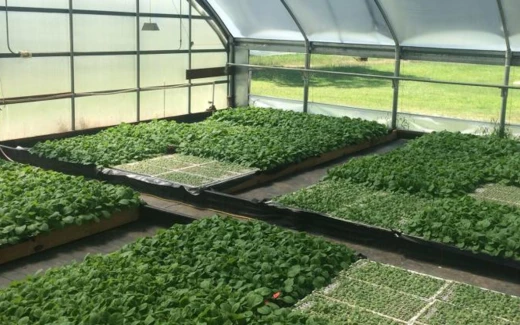- Сидераты осенью: выбор, назначение и особенности
- Особенности сидератов осенью:
- Зачем сеять сидераты осенью?
- Роль сидератов в обогащении почвы
- Влияние сидератов на сохранение влаги
- Защита почвы от эрозии с помощью сидератов
- Особенности выбора сидератов в зависимости от почвы
- Виды сидератов для песчаных почв
- Сидераты для глинистых почв: особенности выбора
- Сидераты для кислых почв: влияние на pH
- Сидераты для щелочных почв: особенности и рекомендации
- Особенности выращивания разных культур сидератов
- Сидераты – что это и для чего их сеять?
- Какие сидераты сеять и в чем их особенности?
- Особенности выращивания разных культур сидератов
- Влияние осенних сидератов на урожай следующего года
- Вопрос-ответ:
- Какие культуры можно использовать в качестве сидератов осенью?
- Зачем сеять сидераты осенью?
- Какие особенности разных культур-сидератов осенью?
- Какие культуры-сидераты лучше всего подавляют сорняки?
- Какие культуры-сидераты подходят для улучшения структуры почвы?
- Видео:
- Косить или не косить горчицу на сидераты

Осень — идеальное время для посева сидератов, так как они обладают рядом особенностей, которые позволяют им успешно развиваться и давать максимальную пользу почве. Сидераты — это растения, которые выращиваются с целью улучшения почвы и подготовки ее к следующему сезону. Они позволяют восстановить плодородие почвы, улучшить структуру и водопроницаемость, подавить сорняки и болезни, а также улучшить ее качество.
Одним из самых популярных сидератов осенью является горчица. Горчица обладает неплохой засухоустойчивостью, а ее корни способны проникать глубоко в почву, улучшая ее структуру. Кроме того, горчица справляется с подавлением сорняков и болезней, что позволяет сократить использование химических удобрений и пестицидов. Ее растительные остатки вносятся в почву, обогащая ее органическим веществом и микроэлементами.
Еще одним интересным сидератом для осеннего посева является фацелия. Это растение обладает высокими декоративными свойствами и привлекает полезных насекомых, таких как пчелы и осы. Фацелия также справляется с подавлением сорняков, улучшает структуру почвы и обогащает ее азотом. Ее цветение привлекает не только полезных насекомых, но и создает красивый вид на грядке или в саду.
Сидераты осенью: выбор, назначение и особенности

Сидераты – это растения, которые выращиваются с целью улучшения почвы и подготовки ее к следующему сезону посева. Осенью особенно важно выбрать правильные сидераты в зависимости от почвы и климатических условий.
Какие сидераты сеять осенью? Оптимальными вариантами являются злаковые культуры, такие как рожь, ячмень или овес. Они хорошо развивают корневую систему, что способствует более глубокому проникновению в почву и улучшению ее структуры.
Особенности сидератов осенью:
- Высокая засухоустойчивость. Многие сидераты являются устойчивыми к засухе, что особенно актуально для осеннего периода, когда вероятность недостатка влаги в почве достаточно высока.
- Улучшение структуры почвы. Сидераты способствуют разрыхлению и улучшению структуры почвы благодаря своей корневой системе, которая проникает на значительную глубину.
- Подавление сорняков. Некоторые виды сидератов обладают способностью подавлять рост сорняков, что помогает сократить использование химических средств защиты.
- Повышение плодородия почвы. Сидераты обогащают почву органическими веществами и микроэлементами, что способствует повышению ее плодородия и урожайности.
В итоге, выбор сидератов осенью зависит от множества факторов, включая тип почвы, климатические условия и цели выращивания. Однако, независимо от выбранной культуры, сидераты осенью являются важным элементом возделывания различных культур, способствуя улучшению почвы и повышению ее плодородности.
Зачем сеять сидераты осенью?

В осеннем периоде сеяние сидератов играет важную роль в подготовке почвы к следующему сезону. Основная цель сеяния сидератов осенью — улучшение структуры почвы и ее плодородия.
Особенности сеяния сидератов осенью заключаются в том, что это процесс проводится перед наступлением зимы, во время которого сельскохозяйственные культуры не растут. Таким образом, сидераты могут заполнить пустующее пространство и заняться активным ростом, улучшая почву.
Выбор сидератов осенью зависит от целей, которые вы хотите достичь. Некоторые виды сидератов, такие как горчица, фацелия и ржа, могут помочь в борьбе с сорняками, предотвращая их рост. Другие сидераты, такие как люцерна и клевер, способствуют обогащению почвы азотом и улучшают ее структуру.
Важно также учитывать особенности разных культур. Некоторые сидераты, например, горчица и фацелия, легко адаптируются к разным типам почвы и климатическим условиям, что делает их универсальными выборами. Другие виды, такие как ржа, могут быть более требовательными к условиям выращивания и могут быть более подходящими для определенных типов почвы.
Роль сидератов в обогащении почвы
Сидераты – это растения, которые сеют осенью на полях после сбора основных культур. Они играют важную роль в обогащении почвы различными питательными веществами и улучшении ее структуры.
Один из важных аспектов выбора сидератов – это их способность обогащать почву азотом. Некоторые сидераты, например, горчица или люцерна, способны захватывать атмосферный азот и обогащать им почву. Это особенно полезно перед посевом культур, которые требуют большого количества азота, например, зерновых или овощных культур.
Кроме того, сидераты помогают улучшить структуру почвы. Корни сидератов проникают глубоко в почву, разрыхляя ее и улучшая ее воздухо- и влагообмен. Они также способствуют образованию гумуса, что повышает плодородие почвы.
Сидераты также могут предотвратить эрозию почвы. Их плотная зеленая масса и корни удерживают почву на месте и не позволяют ей смываться при дождях или под действием ветра. Это особенно актуально для засушливых районов или для полей на склонах.
Какие сидераты выбрать для посева осенью? В зависимости от целей и особенностей почвы можно выбрать разные сидераты. Например, горчица и рапс хорошо подходят для улучшения структуры почвы и обогащения ее азотом. Овес или рожь могут быть хорошими вариантами для предотвращения эрозии почвы.
Важно помнить, что каждая культура имеет свои особенности и требования к почве и климату. Поэтому перед выбором сидерата стоит ознакомиться с его особенностями и учесть условия на своем участке.
Влияние сидератов на сохранение влаги

Сидераты осенью играют важную роль в сохранении влаги в почве. Они помогают удерживать влагу, которая образуется в осенний период. Это особенно важно для районов с небольшими осадками, где вода в почве может быстро испаряться.
Одним из способов, которым сидераты помогают сохранить влагу, является их способность создавать плотное покрытие почвы. Когда сидераты растут, они образуют густую зеленую массу, которая защищает почву от высоких температур и солнечного излучения. Это помогает предотвратить испарение влаги и сохранить ее в почве.
Кроме того, сидераты также способствуют улучшению структуры почвы. Они проникают своими корнями в глубокие слои и разрушают землистые комки. Это увеличивает водопроницаемость почвы и способствует ее удержанию влаги. Кроме того, разложение органического материала сидератов в почве улучшает ее плодородие и способность удерживать влагу.
Таким образом, сидераты осенью играют важную роль в сохранении влаги в почве. Они помогают удерживать воду, предотвращают ее испарение и улучшают структуру почвы. Выбор разных культур сидератов и определение того, какие сеять, зависит от конкретных условий и целей земледелия. Но в любом случае, сидераты являются эффективным инструментом для сохранения влаги и повышения плодородия почвы.
Защита почвы от эрозии с помощью сидератов

Сидераты осенью играют важную роль в сохранении плодородия почвы и предотвращении ее эрозии. Они помогают удерживать почву на месте и улучшают ее структуру.
Как правило, сидераты сеются осенью, перед началом зимы. Они обладают устойчивостью к низким температурам и могут развиваться даже при отсутствии активного вегетационного периода.
Какие сидераты выбрать для защиты почвы от эрозии? Основными культурами, которые применяются в этом случае, являются злаки и бобовые. Злаки, такие как рожь, ячмень и овес, обладают мощной корневой системой, которая удерживает почву и предотвращает ее смыв. Бобовые культуры, такие как клевер и люпин, способствуют образованию корневых клубеньков, которые обогащают почву азотом и улучшают ее структуру.
Зачем сеять сидераты осенью? Они выполняют несколько функций, одна из которых — защита почвы от эрозии. Время между уборкой основных культур и началом следующего сезона можно использовать для посева сидератов, которые будут расти и закрывать почву. Это поможет предотвратить смыв почвы под воздействием дождей и снега, а также сохранить ее плодородие.
Особенности сидератов заключаются в их способности к быстрому росту и образованию плотного растительного покрова. Это позволяет им эффективно защищать почву от эрозии и подавлять сорняки.
Таким образом, сидераты осенью играют важную роль в сохранении плодородия почвы и предотвращении ее эрозии. Выбор культур, таких как злаки и бобовые, а также правильный посев помогут обеспечить надежную защиту почвы и сохранить ее плодородие.
Особенности выбора сидератов в зависимости от почвы

Выбор сидератов осенью зависит от состояния и характеристик почвы, на которой планируется выращивание будущих культур. Разные типы почв требуют разных сидератов и их различных качеств. Важно учитывать такие факторы, как структура, плодородие, кислотность и влажность почвы.
Сидераты могут быть поделены на несколько групп в зависимости от почвенных особенностей:
- Сидераты для суглинистых почв: на таких почвах рекомендуется использовать сидераты, которые способствуют улучшению структуры почвы и ее грунтового плодородия. Хорошим выбором будут горчица, а также редис, озимые ржи и гречиха.
- Сидераты для кислых почв: при выращивании сидератов на кислых почвах важно выбирать те, которые способны увеличить уровень pH и снизить кислотность. В этом случае рекомендуется использовать клевер, люцерну и бобовые культуры, такие как горох и соя.
- Сидераты для легких песчаных почв: на таких почвах особенно важно обеспечить сохранение плодородия и увлажненности. Для этого хорошим выбором будут сидераты, которые обладают хорошей зеленой массой и хорошо удерживают влагу, например, люцерна, горох и гречиха.
Выбор сидератов в зависимости от почвы позволяет оптимизировать процесс улучшения ее качества и подготовить почву для успешного выращивания будущих культур. Кроме того, сидераты способствуют борьбе с сорняками, предотвращают эрозию почвы и улучшают ее структуру.
Виды сидератов для песчаных почв
Сидераты – это растения, которые сеют на поле с целью улучшения его качества и состава почвы. Песчаные почвы имеют свои особенности, поэтому выбор сидератов для таких почв требует особого внимания.
Зачем сеять сидераты на песчаных почвах?
Сеяние сидератов на песчаных почвах позволяет улучшить их структуру и плодородие. Сидераты способствуют удержанию влаги в почве, предотвращают ее вымывание и эрозию. Кроме того, сидераты вносят в почву органические вещества и питательные вещества, улучшают ее структуру и способствуют развитию полезных микроорганизмов.
Какие сидераты выбрать для песчаных почв?
Для песчаных почв хорошо подходят такие сидераты, как люцерна, горчица, фацелия, озимая рожь и гречиха. Люцерна способна улучшить плодородие почвы и обогатить ее азотом. Горчица имеет общеукрепляющее действие на почву и улучшает ее структуру. Фацелия помогает бороться с сорняками и удерживает влагу в почве. Озимая рожь и гречиха также способствуют улучшению структуры почвы и внесению органических веществ.
Так стоп!!! Вы всё ещё не подписаны на наши каналы в Телеграмм и Дзен? Посмотрите: ТГ - (@historyfantasydetectivechat) и Дзен (https://dzen.ru/myshortsstorys)
Особенности разных сидератов для песчаных почв
Разные сидераты для песчаных почв имеют свои особенности. Например, люцерна является многолетним растением и хорошо переносит суховеи. Горчица быстро разрастается и хорошо подавляет сорняки. Фацелия обладает быстрым ростом и образует густую зеленую массу. Озимая рожь и гречиха устойчивы к неблагоприятным погодным условиям и могут использоваться как кормовые культуры.
Сидераты для глинистых почв: особенности выбора

Глинистые почвы характеризуются плотной структурой, низкой плодородностью и плохой воздухопроницаемостью. Чтобы улучшить их состояние, рекомендуется использовать сидераты — растения, сеянные специально для улучшения почвы.
Выбор культур сидератов для глинистых почв должен основываться на нескольких особенностях. Во-первых, такие сидераты должны обладать глубоким корневым аппаратом, который сможет проникнуть в глинистый слой и разрушить его структуру. Во-вторых, культуры должны хорошо переносить затяжные дожди и недостаток солнечного света, так как глинистые почвы обычно задерживают влагу и медленно высыхают. В-третьих, сидераты должны обладать высокой урожайностью и биомассой, чтобы обеспечить эффективное улучшение почвы.
Популярными культурами сидератов для глинистых почв являются рапс, горчица, люпин, рожь и гречиха. Рапс и горчица отличаются глубоким корневым аппаратом и высокой стойкостью к неблагоприятным условиям. Люпин и гречиха являются хорошими азотфиксаторами, что способствует обогащению почвы азотом. Рожь хорошо переносит затяжные дожди и способна разрушать глинистую структуру почвы.
Сеять сидераты на глинистых почвах рекомендуется осенью. Какие именно культуры выбрать зависит от конкретных особенностей почвы и требований к улучшению ее состояния. Например, рапс и горчица можно сеять как чистыми посевами или в смеси с другими культурами, такими как рожь или гречиха, для достижения максимальной эффективности. Люпин и гречиха обычно сеются в чистых посевах, так как они способны улучшать почву независимо от других культур.
Сидераты для кислых почв: влияние на pH

Кислые почвы являются одной из проблем при сельском хозяйственном обороте. Кислотность почвы может приводить к низкой урожайности и осложнять рост растений. Чтобы бороться с этой проблемой и улучшить плодородие почвы, можно использовать сидераты.
Зачем сеять сидераты на кислых почвах?
Сидераты для кислых почв имеют способность воздействовать на pH-уровень. Некоторые виды сидератов могут увеличивать кислотность почвы, а другие, наоборот, снижать ее. Таким образом, сидераты позволяют регулировать pH-уровень и приближать его к оптимальному для роста различных культур.
Особенности сидератов для кислых почв
Для улучшения кислотности почвы можно использовать различные виды сидератов. Некоторые из них, такие как белая горчица или люцерна, обладают способностью снижать кислотность почвы благодаря своему корневому аппарату и микроорганизмам, которые помогают превращать органические вещества в доступные растениям формы.
Какие сидераты выбрать для кислых почв?
При выборе сидератов для кислых почв следует учитывать их способность воздействовать на pH-уровень. Некоторые растения, такие как горчица, люпин или клевер, могут повысить кислотность почвы, поэтому их следует использовать в тех случаях, когда нужно снизить pH-уровень. А вот растения, такие как овес, рожь или гречиха, наоборот, способствуют снижению кислотности и могут быть полезны для повышения pH-уровня на кислых почвах.
Сидераты для щелочных почв: особенности и рекомендации
Осенью, когда наступает время подготовки почвы к следующему сезону, важно учитывать особенности разных культур и правильно выбирать сидераты. Для щелочных почв существуют определенные рекомендации, которые помогут улучшить их качество и плодородие.
Одной из главных особенностей щелочных почв является высокий уровень pH, который необходимо снизить для создания оптимальной среды для роста различных культур. Для этого рекомендуется использовать сидераты, которые способны аккумулировать органические кислоты и улучшать кислотно-щелочной баланс почвы.
Среди таких сидератов можно выделить горчицу, саранчу, ржаное полевое люцерновое сено. Горчица и саранча имеют высокую кислотность, а ржаное полевое люцерновое сено содержит органические кислоты, которые способствуют снижению pH почвы.
Однако, прежде чем приступать к посеву, необходимо провести анализ почвы, чтобы определить ее состав и уровень pH. Это позволит выбрать наиболее подходящие сидераты и правильно расчитать их количество для оптимального эффекта.
Помимо снижения pH, сидераты для щелочных почв также способствуют повышению плодородия, улучшению структуры почвы и борьбе с сорняками. Они обогащают почву органическими веществами, удерживают влагу и предотвращают эрозию.
Важно помнить, что сидераты необходимо сеять осенью, за 2-3 недели до начала морозов. Это позволит растениям развиться и закрепиться в почве, а весной они будут готовы к внесению в нее органических веществ и улучшению ее свойств.
Особенности выращивания разных культур сидератов
Сидераты – что это и для чего их сеять?
Сидераты – это растения, которые сеют на поле для улучшения почвы и подавления сорняков. Они играют важную роль в сельском хозяйстве, так как обогащают почву органическими веществами, удерживают влагу и улучшают ее структуру.
Какие сидераты сеять и в чем их особенности?

В зависимости от целей и условий выращивания, выбирают разные культуры сидератов. Например, люпин является отличным источником азота, что особенно полезно для почв с низким содержанием этого элемента. Горчица и редис также сеются для подавления сорняков и предотвращения развития болезней.
Однако, перед выбором сидерата, необходимо учесть особенности почвы, климата и культур, которые будут выращиваться после него. Например, рожь или овес подходят для улучшения структуры почвы и предотвращения эрозии, а горчица – для борьбы с сорняками.
Особенности выращивания разных культур сидератов

Каждая культура сидерата имеет свои особенности выращивания. Например, люцерна требует хорошей освещенности и влаги, поэтому ее не рекомендуется сеять на затененных или сухих участках. А горчица и редис быстро развиваются и обильно цветут, поэтому их рекомендуется сеять в начале весны или осени и периодически подкормливать.
Также, для каждой культуры сидерата существует оптимальный срок посева и глубина заделки семян. Например, горчицу и редис сеют на глубину 1-2 см, а люцерну – на глубину 2-3 см. Точное время и глубину посева рекомендуется уточнить в инструкции к семенам.
Таким образом, особенности выращивания разных культур сидератов должны быть учтены при выборе сидерата для конкретного участка и целей. Только правильно подобранные и ухаживаемые сидераты могут полностью раскрыть свой потенциал и принести пользу почве и будущим культурам.
Влияние осенних сидератов на урожай следующего года

Осенью сидераты играют важную роль в подготовке почвы к следующему сезону. Они помогают улучшить ее структуру и плодородие, что влияет на урожайность и качество посевов.
Какие сидераты выбрать для посадки в осенний период? Здесь необходимо учитывать особенности разных культур. Например, рапс и фацелия являются отличными выборами, так как они усиливают развитие корневой системы и обогащают почву азотом.
Особенности разных сидератов также проявляются в их способности подавлять сорняки. Некоторые виды сидератов, такие как люцерна и горчица, обладают сильным аллелопатическим действием, которое позволяет снизить конкуренцию сорняков.
Зачем сеять осенние сидераты? Они выполняют ряд полезных функций. Во-первых, они предотвращают эрозию почвы и улучшают ее структуру благодаря своей корневой системе. Во-вторых, они повышают плодородие почвы, обогащая ее органическими веществами. И наконец, они подавляют развитие сорняков, что уменьшает необходимость в применении химических гербицидов.
Выводя всю информацию в таблицу, можно увидеть, что разные сидераты имеют разные особенности и применимы в разных ситуациях. Но в целом, осенью сеять сидераты — это хорошая практика, которая поможет улучшить почву и повысить урожайность следующего года.
Вопрос-ответ:
Какие культуры можно использовать в качестве сидератов осенью?
В качестве сидератов осенью можно использовать различные культуры, такие как ржаной редьки, горчица, гречиха, ячмень и другие. Выбор зависит от целей, которые вы хотите достичь: улучшение почвы, подавление сорняков или укрепление корневой системы.
Зачем сеять сидераты осенью?
Сидераты осенью имеют несколько полезных свойств. Они помогают улучшить структуру почвы, повысить ее плодородие, подавить сорняки и защитить почву от эрозии. Кроме того, сидераты осенью могут быть использованы как корм для скота или птиц.
Какие особенности разных культур-сидератов осенью?
Каждая культура-сидерат имеет свои особенности. Например, ржаная редька имеет глубокую корневую систему, которая помогает улучшить структуру почвы и проникнуть в глубокие слои. Горчица обладает высоким содержанием азота, что способствует плодородию почвы. Гречиха имеет высокую устойчивость к засухе и хорошо подавляет сорняки.
Какие культуры-сидераты лучше всего подавляют сорняки?
Среди культур-сидератов осенью особенно хорошо справляются с подавлением сорняков горчица и ржаная редька. Они обладают сильным аллелопатическим эффектом, который предотвращает прорастание семян сорняков и замедляет их рост. Это позволяет значительно снизить количество сорняков в почве.
Какие культуры-сидераты подходят для улучшения структуры почвы?
Для улучшения структуры почвы можно использовать культуры-сидераты с крепкой корневой системой, такие как ржаная редька и горчица. Они проникают в глубокие слои почвы, разрушая ее плотность и улучшая ее воздухообмен. Это способствует более эффективной работе микроорганизмов и улучшает общую плодородность почвы.








